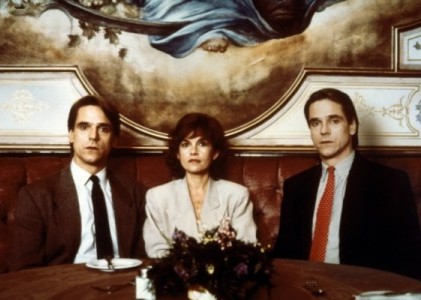Physical Instincts
History is made at night and, at least in my case, watched bleary-eyed at 5:30 a.m. over coffee. In November, I couldn’t sleep. I would spend evenings after work at Occupy Wall Street, my body propagated across livestream now and then as a symbol of brazen youth inside a thousand anonymous bedrooms of similarly bleary-eyed insomniacs; by midnight, tucked in, warming myself up slowly, I would watch Carpenter films and Dead Ringers on repeat. The loneliness of having a body—but my mind, wherever it was, was on genre, and thinking that genre could be a body transplant of sorts, a series of reconstructed appendages to approximate an ultimate, mass-manufactured body, story, romance. As a remake and clone of a hundred horror films, Dead Ringers could be remade from them, could be resurrected from the spare limbs of old buried objects, so that the ghosts of ’80s body horror could be given life, while Dead Ringers could become a phantom duplicate of itself, dismembered across the detritus of a moth-eaten Hollywood. Of course what’s interesting is not that the limbs are the same, but how different each is in playing the same function, same role.
It goes without saying about body language: every gesture—every supplication of a cupped palm, every spin of an index finger, every hokey-pokey—is the tracing of a phantom thought through the air. Of course, as Cronenberg and monster movies show, it’s usually the body that thinks before the mind. So with a found-footage, montage-movie, I found myself with the same issues of any shit-grade horror filmmaker collapsing traditional hierarchy of thought/action, mind/body, inside/outside, in which the latter is nothing but a symbol of the former. To abolish psychology, the subordination of body to the dictates of the mind, of morality, of narrative, just means showing the image, the body, as speaking for nothing but itself.
"The expression of an isolated face is intelligible all by itself, we don’t have anything to add to it by way of thought, nor of time nor space....Confronted with an isolated face, we don’t perceive space. Our sense of space is abolished," wrote Béla Balázs about the close-up, that affect that not only internalizes and embodies a response but in so doing internalizes and embodies the object being responded to. As Deleuze would point out, the close-up abolishes the geometric coordinates of time and space only as their mute witness. Still we can wonder: What if other body parts besides the face, or what if any image altogether, could serve this function as affect? Entire scenes would be rendered superficial, embodied and internalized—inside-made-outside—in the superficiality of limbs and visions expressing themselves mutely onscreen. In this cinema of affects, there would be no inside/outside, no delineation of shot/countershot, action/thought, when every shot is a countershot balanced against the others, each silently metamorphosing into the next. The body of the movie could rethink itself into new forms across a 20th-century history of B-movies, the nightmare responses to the violent, daylight realities of women held at stainless steel ovens to smell cobbler and dream of their men at war.
I imagined making a movie, the opposite of my previous ones, that could take place in no time or space but the ether of a movie-lover's broken dreams. "The structure Inside-Outside or Day-Night has no meaning in a pure space given over to itself and disoriented," wrote Jacques Derrida. To sew together a few movies only by hacking them to bits moment-to-moment and scene-to-scene.
No inside, no outside. "This is the affect-image," said Deleuze. "It has as its limit the simple sense of fear and the effacement of faces into nothingness. But as its substance it has this sense composed of desire and of surprise, which give it life, and the turning of faces out in the open, in the flesh." In the dark, I would shiver because I was cold, because I was anxious, and sometimes unsure which was which, body or mind. Of course there was nothing to look at.
Though hybrid parts are easily interchanged, that anonymity—when our words, our voices, our bodies are no longer our own, no longer belong to us at all—comes too from a total individuality that they express, these phantom limbs, nothing but themselves. So in this affect-film, the things onscreen would have no inside or outside, no meaning except in themselves: images, rhythms, gestures. As pure cinema, it would be a Frankenstein monster, ghost-written no more by me than however many unnamed and incognito artists and voices from the shadows of a history that at this point can seem half-imagined, half-projected onto a blurry present. Doesn’t really matter whether I puppeteered them or they me. It is what it is. ![]()
LATEST ARTICLES
-20140814-173707-thumb3.jpg)
Fighting Words
by Imogen Sara Smith
posted August 12, 2014

Fighting Words, Part 2
by Imogen Sara Smith
posted August 20, 2014

On the Margins: The Fil…
by Andrew Chan
posted August 12, 2014

Robin Williams: A Sense…
by David Schwartz
posted August 12, 2014
 Physical Instincts
Physical Instincts
 Dead Ringers
Dead Ringers
RELATED ARTICLE
Laws of Desire by Tom McCormackMigrating Forms by Joshua Land
More: Article Archive
THE AUTHOR
Gina Telaroli just completed a feature film entitled Traveling Light.
More articles by Gina TelaroliAuthor's Website: Gina Telaroli

